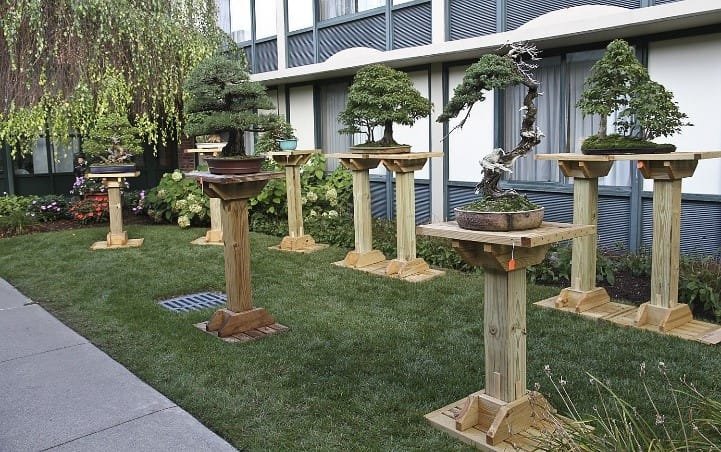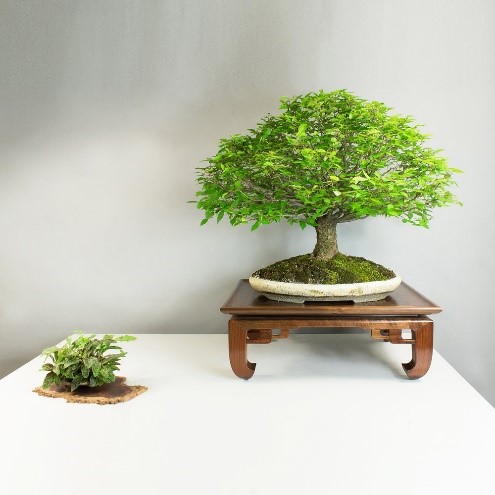A bonsai tree is meant to bring pleasure to the senses when contemplated. Displaying your miniature masterpiece in the best possible way can be compared to adding the final touches to just about any artwork; details truly matter.
In order to learn how to display bonsai using stands, you need to think about the big picture – your choice of pot, stand, companion objects and placement of the display are all factors that you should carefully consider.
How to Select a Suitable Bonsai Stand

A bonsai stand is originally referred to with the Japanese term “shoku” (卓) or “bonsai shoku” (盆栽卓). Nevertheless, the Japanese word “dai” (台) is also translated as “stand,” while “kadai” (架台) refers to a stand or frame.
Bonsai stands are not limited to stand tables. Instead, a bonsai stand can also be a floor stand.
What is important is that you pick a stand that allows for the contemplators to view the bonsai tree at eye level.
Displaying your bonsai at eye level is crucial for achieving the desired visual appeal that triggers emotional responses because of the opposition of the tiny size of the tree to its authentic resemblance to large tree species growing freely in the wild.
While striving to display a bonsai tree at eye level, there are many tiny details that you need to consider. In some cases, the display may not be best-suited at precise eye level height – a topic that is discussed in detail in The Myth of the Single Front. What truly matters is that you take time for contemplation.
Most noteworthy, a great bonsai stand must not, at any cost, distract the attention from the bonsai tree itself.
Always remember that it is the tree that must receive the entire attention and admiration it deserves while the stand merely serves the purpose of harmonizing the surroundings as to further enhance the magnificence of the miniature tree.
With this in mind, it is best to avoid using stands that are overly ornamented. Simplicity is key in the Japanese tradition and aesthetics. Undergoing a spectacular renaissance and highly influenced by the centuries-old principles of Zen Buddhism, both simplicity and minimalism are currently back on the rise in the homeland of the art of bonsai – Japan.
Video by: CAN Insider – Being A Minimalist | CNA Insider
Source: youtube.com
When it comes to crafting traditional Japanese bonsai stands, local artisans typically prefer to apply a coat of dark stain finish.
However, if you are about to display a flowering bonsai, a light-colored stand might be much more attractive in complementing the gentle blossoms – a dark-colored stand might be too distracting because of the opposition of colors.
How to Create a Panorama Enhancing the Beauty of Bonsai Displayed on Stands

Knowing the basics of how to display your bonsai using stands does not end with choosing a suitable stand. It is the creation of a uniform panorama that greatly enhances the beauty of your bonsai tree.
Think about how you can showcase the beauty of nature at its best; no distractions, no fluff, no overlapping, no bright colors but a landscape that conveys the feeling of undisturbed peace, tranquility, and serenity.
When selecting an appropriate pot, make sure it corresponds with the current state of your bonsai so that it can complement the bright colors of a Maple bonsai tree in autumn or enhance the exquisiteness of a delicate Cherry bonsai tree in bloom.
In the case of displaying semi-cascading or cascading bonsai, make sure the depth of the pot is not any deeper than approximately ½ of the cascade itself.
If displaying bonsai trees that are stylized as non-cascading, measure the size of the bonsai’s root. Use this measurement as a guide in selecting a pot with a depth that is sized just like the root, measured right above the flare.
Also, consider the width of the branches and pick a pot of the same width.
Since your major goal is not to distract the attention from the bonsai tree itself, you need to think of the natural frame of the display. Use a stand to display your bonsai at the very center of the selected location and try to create the visual illusion of a frame by focusing on the three sides that surround the bonsai. The back of this natural frame should have a neutral, soft color.
You can also take advantage of suitable companion items, such as a small figurine of an animal or some other natural element. But do make sure these elements correspond to the type of bonsai tree you are displaying. For instance, a miniature figurine of an elephant would seem ridiculous placed right next to a Juniper bonsai tree.
A tiny floral plant can also be a suitable companion object, as long as it fits the vibe of your bonsai tree by adding to its authenticity, and not vice versa.
Traditionally, hanging scrolls (“kakemono”) make perfect companion objects as they further bring the Japanese sense of Zen aesthetics. Not the least, “suiseki,” or mountain stones are beloved companion objects for displaying a bonsai tree using stands, too.
If you are the type of person who loves the do-it-yourself approach, you can easily craft a lovely bonsai stand all by yourself!
Video by: Theiss Hilmar – Beautiful Bonsai Woodwork Stand DIY with STIHL 251 Chainsaw
Source: youtube.com
The Wrap-Up

Image Source: Pinterest
In the novel titled Tuck Everlasting, the American writer and illustrator Natalie Babbitt shares a whimsical phrase on the beauty if simplicity.
Babbitt’s immortal wisdom can be perfectly related to learning how to display your bonsai using stands – it is all about embracing harmony in the tiny, non-obtrusive details that only whisper without raising their voice, for beauty doesn’t have to be loud to be fully appreciated.


